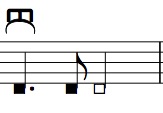An air sound may also be produced by bowing a mute, while it is attached to the bridge of the instrument. As with the tailpiece, it is also possible to activate the mute itself, making it vibrate on the bridge of the instrument. However, this is only possible with a mute made of wood or leather. Metal practice mutes and rubber mutes may elicit an air sound, but will not vibrate against the bridge when bowed.
Examples of bowing on a mute on the bridge in repertoire from recent decades may be found in Helmut Lachenmann’s string writing, including in his string quartets “Reigen seliger Geister” (1989) and Grido (2002, p. 1).[1]An example may also be found in Cristóbal Halffter’s (b. 1930) string writing.[2]
Bowing the mute on the baroque violin:
As with bowing other wooden parts of the baroque violin, bowing on a mute on the bridge is possible on the baroque violin, just as it is with modern string instruments. Again, the only complication can be with the surface area of hair on a baroque or classical bow being smaller and more prone to bunching together due to the unmounted frog. This is shown in Figure 9.1 in the entry entitled Tremolo, spazzolare, arco circolare.
The following is an example of bowing on the mute on the baroque violin bridge, moving from a soft air sound to a louder, heavier bowing pressure where the mute itself is activated.
Video example 13.1 – bowing on wooden mute on baroque violin
Suggested notation:
As in Lachenmann,[3] it is possible to use a tablature notation for bowing on a mute attached to the bridge. Alternatively, a symbol to represent a mute attached to a bridge may be used as shown in Figure 13.1 below.
Figure 13.1 – example of a possible notation for bowing on mute
___________________________________________________________________________________________________
[1] For Lachenmann’s perspective on this technique, and other air sounds found in his string writing, see his article On My Second String Quartet (‘Reigen seliger Geister’) (Lachenmann, 2004, p. 61).
[2] For more information, see Strange and Strange (2001, p. 17).
[3] For an example, see the violin II part from Lachenmann’s Grido (2002, p. 1).
